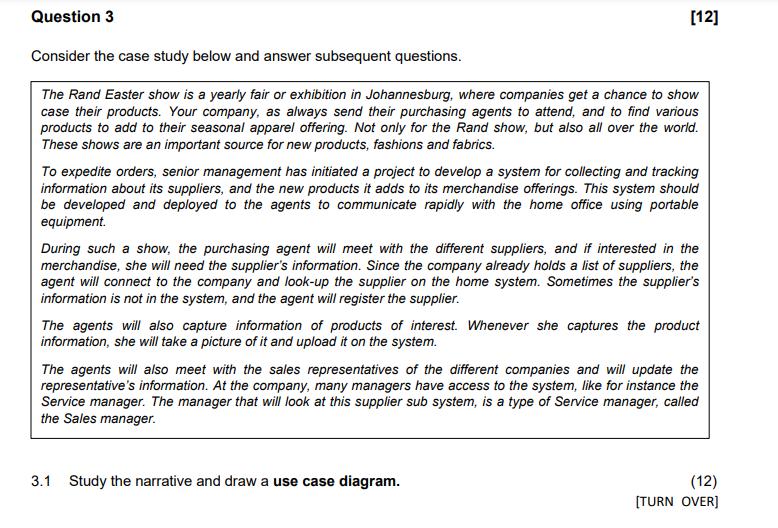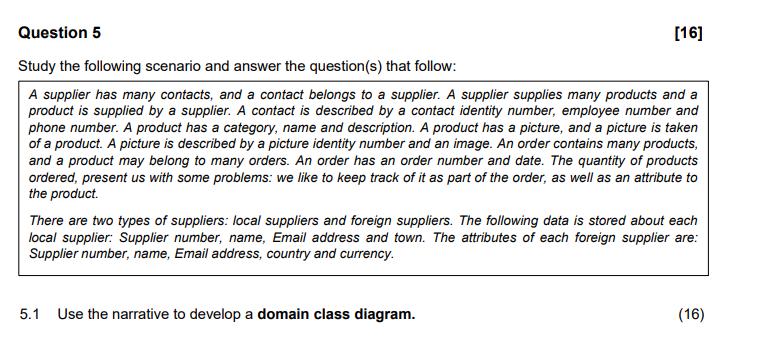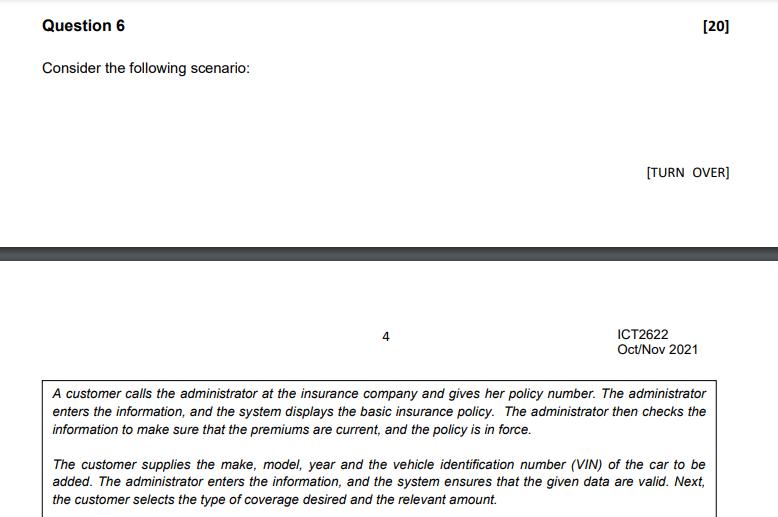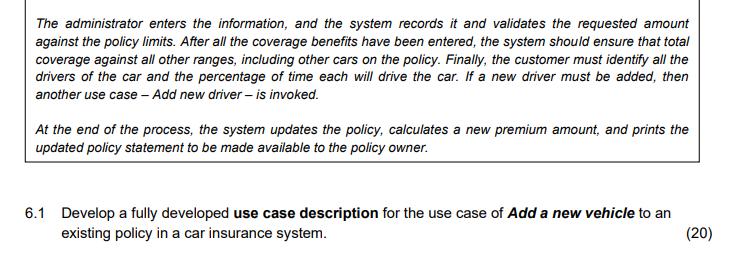Answered step by step
Verified Expert Solution
Question
1 Approved Answer
Question 1 1.1 List and briefly describe the five (5) activities of the systems analysis. Question 2 Consider the following scenario: [10] (10) [6]






Question 1 1.1 List and briefly describe the five (5) activities of the systems analysis. Question 2 Consider the following scenario: [10] (10) [6] In an online bus booking system, a passenger can only book one bus. While a bus must be booked by at least one passenger for it to go on a trip. Each bus may appear in more than one tickets, while a ticket can only have one bus on it. The attributes of a passenger include passenger ID, passenger name, and contact number. A bus is identified by its bus ID and bus company. The attributes of ticket are ticket number, seat number, and departure time. 2.1 Draw a simple entity-relationship diagram (ERD) for this scenario, showing all the attributes, key identifiers and cardinality where necessary. (6) Question 3 Consider the case study below and answer subsequent questions. The Rand Easter show is a yearly fair or exhibition in Johannesburg, where companies get a chance to show case their products. Your company, as always send their purchasing agents to attend, and to find various products to add to their seasonal apparel offering. Not only for the Rand show, but also all over the world. These shows are an important source for new products, fashions and fabrics. [12] To expedite orders, senior management has initiated a project to develop a system for collecting and tracking information about its suppliers, and the new products it adds to its merchandise offerings. This system should be developed and deployed to the agents to communicate rapidly with the home office using portable equipment. During such a show, the purchasing agent will meet with the different suppliers, and if interested in the merchandise, she will need the supplier's information. Since the company already holds a list of suppliers, the agent will connect to the company and look-up the supplier on the home system. Sometimes the supplier's information is not in the system, and the agent will register the supplier. The agents will also capture information of products of interest. Whenever she captures the product information, she will take a picture of it and upload it on the system. The agents will also meet with the sales representatives of the different companies and will update the representative's information. At the company, many managers have access to the system, like for instance the Service manager. The manager that will look at this supplier sub system, is a type of Service manager, called the Sales manager. 3.1 Study the narrative and draw a use case diagram. (12) [TURN OVER] Your diagram should include at least one include, one extend and one generalization relationship. Question 4 Consider the following scenario and answer the question(s) that follow: One of the use cases, "Look up supplier', is described as follows: The purchasing agent will enter the supplier's name, and the system will search for it on the database. If the system finds it, it will return the supplier's information for the agent to view. If it does not exist on the database, it will prompt the agent to enter the necessary data. After capturing this data, the system will update the database, and the system will display the information to the agent. [16] The agent will view the data and select a contact name. (Suppliers usually provide many contact names). The system will retrieve the contact information, and the agent will view it. 4.1 Use the above information to draw an activity diagram. (16) Question 5 Study the following scenario and answer the question(s) that follow: A supplier has many contacts, and a contact belongs to a supplier. A supplier supplies many products and a product is supplied by a supplier. A contact is described by a contact identity number, employee number and phone number. A product has a category, name and description. A product has a picture, and a picture is taken of a product. A picture is described by a picture identity number and an image. An order contains many products, and a product may belong to many orders. An order has an order number and date. The quantity of products ordered, present us with some problems: we like to keep track of it as part of the order, as well as an attribute to the product. [16] There are two types of suppliers: local suppliers and foreign suppliers. The following data is stored about each local supplier: Supplier number, name, Email address and town. The attributes of each foreign supplier are: Supplier number, name, Email address, country and currency. 5.1 Use the narrative to develop a domain class diagram. (16) Question 6 Consider the following scenario: [20] [TURN OVER] ICT2622 Oct/Nov 2021 A customer calls the administrator at the insurance company and gives her policy number. The administrator enters the information, and the system displays the basic insurance policy. The administrator then checks the information to make sure that the premiums are current, and the policy is in force. The customer supplies the make, model, year and the vehicle identification number (VIN) of the car to be added. The administrator enters the information, and the system ensures that the given data are valid. Next, the customer selects the type of coverage desired and the relevant amount. The administrator enters the information, and the system records it and validates the requested amount against the policy limits. After all the coverage benefits have been entered, the system should ensure that total coverage against all other ranges, including other cars on the policy. Finally, the customer must identify all the drivers of the car and the percentage of time each will drive the car. If a new driver must be added, then another use case - Add new driver - is invoked. At the end of the process, the system updates the policy, calculates a new premium amount, and prints the updated policy statement to be made available to the policy owner. 6.1 Develop a fully developed use case description for the use case of Add a new vehicle to an existing policy in a car insurance system. (20)
Step by Step Solution
★★★★★
3.39 Rating (149 Votes )
There are 3 Steps involved in it
Step: 1
1 Five activities of systems analysis Collect complete information Define requirements Prioritize re...
Get Instant Access to Expert-Tailored Solutions
See step-by-step solutions with expert insights and AI powered tools for academic success
Step: 2

Step: 3

Ace Your Homework with AI
Get the answers you need in no time with our AI-driven, step-by-step assistance
Get Started


